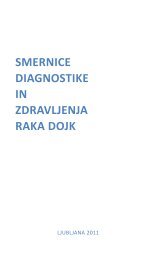You also want an ePaper? Increase the reach of your titles
YUMPU automatically turns print PDFs into web optimized ePapers that Google loves.
Inhibition of mouse uPA activity by monoclonal<br />
antibodies against mouse uPA<br />
Ida K. Lund, Niels Behrendt, Michael Ploug, Henrik Gårdsvoll, John Rømer,<br />
Keld Danø, Gunilla Høyer-Hansen<br />
Finsen Laboratory, Strandboulevarden 49, DK-2100 Copenhagen Ø<br />
The potential of monoclonal antibodies (mAbs) as anti-cancer therapeutics has lately<br />
been demonstrated for a number of antigens. As the clinical relevant mAbs are<br />
directed against human antigens, the initial in vivo studies in mice have been limited<br />
to xenotransplanted tumors, which are in many respects poor models for human<br />
cancers. To enable in vivo therapeutic experiments of mAbs in murine cancer models,<br />
we have utilized immunization of mice deficient for the target protein in question,<br />
thus developing murine antibodies directed against the murine antigen. In the<br />
present study, we have generated murine mAbs to murine urokinase plasminogen<br />
activator (muPA) by immunization of uPA deficient mice with recombinant muPA.<br />
We have selected 5 mAbs (i.e. mU1-mU5) that react with muPA in ELISA, in Surface<br />
Plasmon Resonance (SPR) analysis, and in Western blotting. None of these antimuPA<br />
mAbs recognized reduced and alkylated muPA in Western blotting. Therefore,<br />
the reactivity of the mAbs was further analyzed using recombinant amino-terminal<br />
fragment of muPA (mATF) in Western blotting. The results revealed that all but one,<br />
namely mU1, recognized epitopes in mATF. Since mU1 reacted with intact muPA and<br />
not with mATF, its epitope is located in the B-chain, which encompass the catalytic<br />
site of muPA. No cross-reactivity with human uPA was observed with any of the<br />
five mAbs. The ability of the mAbs to bind to receptor (muPAR)-bound muPA was<br />
tested by SPR analysis. One mAb, mU2, was incapable of binding to receptor-bound<br />
muPA, indicating overlapping binding sites on the growth factor domain (GFD) in<br />
the muPA A-chain. The 3 residual mATF-reacting mAbs bound muPA independently<br />
of the presence of muPAR.<br />
The influence of these different mAbs on the uPA activity was studied by an enzyme<br />
kinetic assay measuring the uPA-dependent activation of plasminogen. One mAb,<br />
mU5, stimulated the muPA activity while the other 4 mAbs inhibited the reaction<br />
to various extend. Furthermore, all 4 mAbs induced a dose-dependent reduction of<br />
the muPA activity with mU1 having the most pronounced inhibitory effect. Thus,<br />
despite the different epitope locations on muPA, i.e. various sites on either the A- or<br />
B-chain, the mAbs inhibited the muPA activity. These mAbs will now be tested in<br />
vivo for their effect on tumor growth and metastasis in murine cancer models.<br />
p2395

















